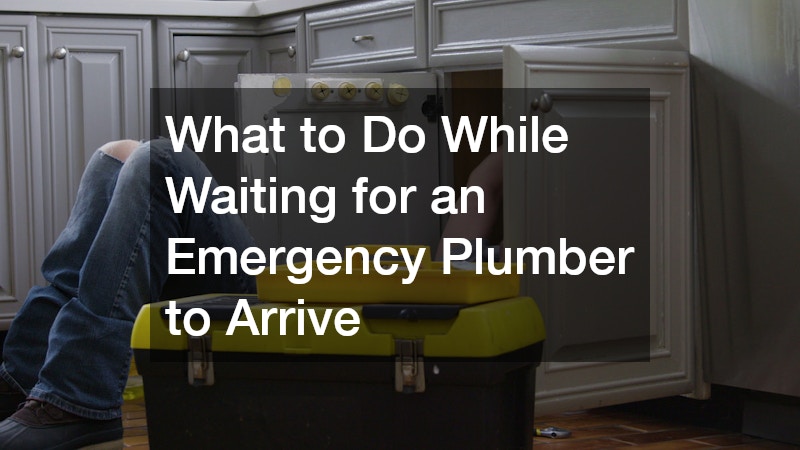When a plumbing disaster strikes, your first reaction might be panic. Whether it’s a burst pipe, a leaking water heater or an overflowing toilet, quick action is essential to limit the damage. Once you’ve called an emergency plumber, you might feel like all you can do is wait. But that time can be put to good use to protect your home and prepare for repairs.
Knowing what to do in those critical minutes before the emergency plumber arrives can save you money, reduce damage and keep your family safe.
Shut Off the Water Immediately
The first thing to do in any plumbing emergency is to stop the flow of water. Most homes have a main water shut-off valve, often located near the front garden tap, under the kitchen sink or in a laundry room. Turning it off can prevent further flooding and water damage while you wait for professional help.
If the issue is with a specific fixture, like a toilet or sink, you might also be able to shut off the water directly at the source. Look for small valves behind the appliance or under the counter. Stopping the water early can be one of the most effective ways to prevent costly repairs.
Turn Off the Power If Needed
If water has reached electrical outlets or appliances, it’s vital to cut the power to avoid electrocution or fire hazards. Do not touch anything electrical if it’s wet. Head straight to the switchboard and turn off the electricity to the affected areas.
Be cautious and never risk your safety. If you’re unsure whether it’s safe to approach, it’s better to stay clear and wait for the emergency plumber to assess the situation.
Remove Standing Water
Once it’s safe, begin removing any standing water with towels, mops or buckets. The longer water sits, the more damage it can cause to floors, walls and furniture. Wipe down surfaces and move rugs or small furniture to a dry area if possible.
You don’t need to clean up everything before the plumber arrives, but limiting water exposure can prevent the development of mould and long-term structural issues.
Protect Belongings and Furniture
After clearing excess water, assess nearby belongings. Items like books, electronics, photos and soft furnishings should be moved to dry areas to prevent lasting damage.
If furniture is too heavy to move, consider placing foil or wooden blocks under the legs to lift them off the wet floor. This step not only protects your belongings but also makes it easier for the plumber to access the affected area when they arrive.
Ventilate the Area
Opening windows and doors can help dry out the space and reduce humidity. If the weather permits, good airflow will speed up evaporation and reduce the risk of mildew.
Using fans or a dehumidifier can also be helpful if available. These actions don’t replace professional drying equipment but can provide a head start until the plumber gets there.
Make Notes and Take Photos
Documenting the situation before the emergency plumber arrives is useful for insurance purposes. Take photos of the leak, water damage and any affected belongings. These images can serve as evidence if you need to claim with your home insurer.
You should also write down the time the issue started, what you’ve done so far and anything unusual you’ve noticed. This information can assist the plumber in diagnosing the issue more efficiently.
Keep Everyone Safe
Depending on the type of plumbing issue, it’s best to keep children and pets away from the area. Wet floors are slippery and can lead to accidents. There’s also the risk of coming into contact with contaminated water if the problem involves sewage or toilet overflow.
Until the plumber gives the all-clear, restrict access to the affected parts of the home to avoid injury or further mess.
Be Ready to Describe the Problem
When the emergency plumber arrives, you’ll want to give them a quick, clear rundown of what happened. Let them know when the issue started, what steps you’ve already taken and where you’ve noticed damage.
The more information you can provide, the faster they’ll be able to get to the root of the problem and begin repairs.
Stay Calm and Trust the Process
It’s easy to feel overwhelmed when water is flooding your kitchen or the toilet won’t stop running. But panicking won’t help the situation. By staying calm and focused on simple steps, you’ll gain back some control and reduce the chances of further damage.
Emergency plumbers are trained to handle these situations and will know the best course of action once they arrive. Your preparation can make their job quicker and more efficient.
After the Emergency Has Passed
Once the plumber has resolved the issue, take the time to review what went wrong. Ask for advice on how to prevent future incidents and whether follow-up work is needed.
It might also be a good idea to schedule a full plumbing inspection shortly to ensure no hidden issues are waiting to resurface.
While plumbing emergencies are never convenient, knowing what to do while waiting for an emergency plumber can make a world of difference. By turning off the water, staying safe and preparing the area, you give yourself the best chance of limiting damage and speeding up repairs.
Having a plan and staying calm means you can turn a stressful situation into a manageable one, and your home will be better off for it.

